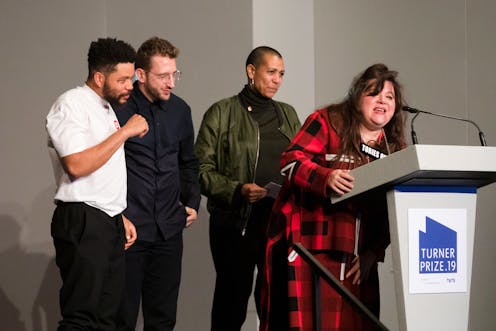(Almost) everyone's a winner? Art is meant to break rules and prizes must adapt
- Written by Lachlan Warner, Australian Catholic University

Last week Britain’s Turner Prize for visual art was announced. For the first time, the award went to a collective instead of the usual singular winner. The four finalists – Helen Cammock, Oscar Murillo, Tai Shani and Lawrence Abu Hamden – came together “to make a statement in the name of commonality, multiplicity and solidarity – in art as in society”. The judges agreed and the single prize was shared.
There were, of course, negative responses. Tenuous links were made to joint Booker prize winners and even those who had shared the dubious bad sex writing gong.
While there has been outcry – the usual media and social hyperbole about the artists changing the rules, creating themselves as multiple winners, and making everyone a winner – art is meant to break rules. And prizes must adapt.
Walking the walk
This hasn’t happened before. But why is that a shock? We’re talk about contemporary art, after all. To recast the late Robert Hughes’ book title, the “shock of the new” continues in art, even if it’s a very, very, mild shock in this case.
The important issue in this win is the nature of the four artists’ work chosen for the final show. All four are working in and around similar themes of societal exclusion. The critical point is that their mutual decision is very much in line with their practices. It is a strengthening of their voices and truth. This can only be a good thing for their art, its reception and just as importantly, for other artists that work in similar ways.
While the joint Turner Prize was about the collective action of the finalists, the Booker judges’ decision was about not, by necessity, making the invidious call between two deserving candidates. Neither of these decisions were about an “everyone is a winner” mentality.
There are of course inherent flaws in any prize situation. Judges need to be discriminating and this can be either positive or negative, or even both.
I have been part of this process, as both a contestant and a judge. I have been on the judging panel for the Blake, Clancy and Strathfield art prizes. Both sides of a prize need to be taken with a grain of salt.
Being judged
As an artist, there is something to be said for being in most prize exhibitions and I do hope to be at least a finalist again. The prizes are in some ways a reality check about what I am making as an artist.
Artmaking for me is about constant doubt. Is this the best of what I am doing? Will anyone else get it (yet)?
Selection as a finalist is a recognition by judges that people are finding their own voice, tenacity and truth. For an artist the exhibition is a confidence builder against this necessary doubt.
As a judge, you can see that conviction in the works.
There are also the simply pragmatic questions for artists about putting a work into competitions. Who is judging? What will it cost to prepare and transport the work? Is it worth it? (On the cost issue I do have a related question about competitions charging entry fees for artists and then charging the audience.)
Judging
On the other side of the equation are the judges and what direction the judging panel may take. As the judge of art prizes, I’ve witnessed intense and focussed deliberations but also vividly recall one instance when a fellow judge got very hot-headed and upset about the course of events.
That heat seemed mostly to be about self-righteousness and less about the openness needed to take on the new and unexplored in art.
Are prizes are relevant? If you win, yes, you bet! It isn’t just about the money, but that money can be a really good leg up for many artists on low incomes. My first car came from prize money and it made moving art materials around a whole lot easier.
Prizes are about recognition that goes beyond 15 minutes of fame. Prizes also present the important question of where to go next.
Ultimately, this year’s Turner Prize helps keep contemporary art and practice in the public domain and sparks engagement. Liking or dismissing the artworks or the judging are all possible but wrestling with the work is so much better.
Authors: Lachlan Warner, Australian Catholic University





